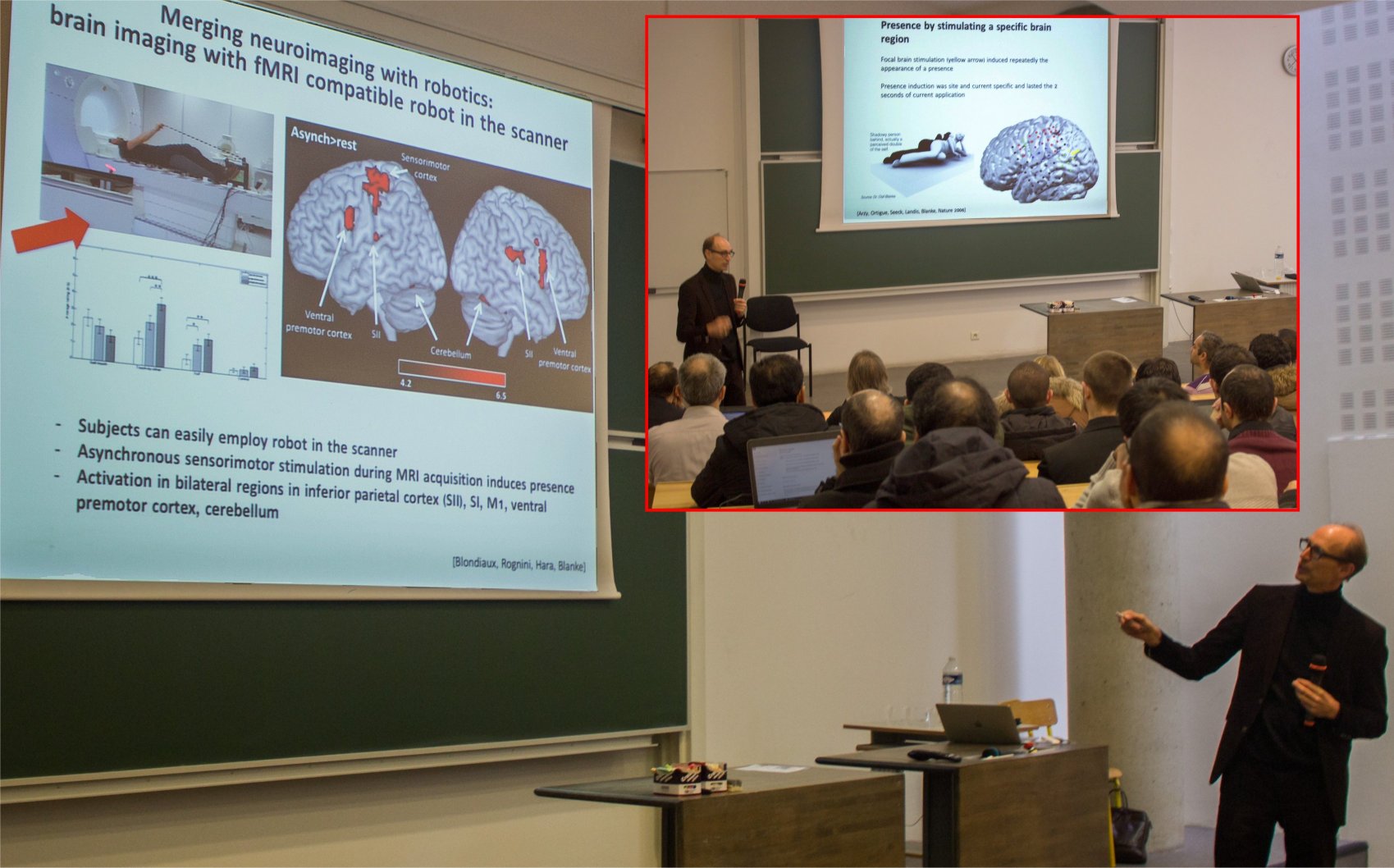Journée FéDeV 2017 : Jeudi 9 Novembre 2017
La journée s’est tenue sur le campus de l’Université de Versailles Saint-Quentin-en-Yvelines à l’IUT de Vélizy, 10-12 Avenue de l’Europe, 78140 Vélizy-Villacoublay
PROGRAMME
8h15 : Arrivée Organisateurs
8h45-9h00 : Accueil du Conseil de Fédération
9h00-10h00 : Réunion Conseil de Fédération
9h30-10h10 : Accueil public / Pause café
10h10 : Discours d’ouverture de la Journée FéDEV 2017
10h15-11h00 : Conférence plénière
« Ghosts, neuroscience, and robotic psychiatry » by Olaf Blanke
Bertarelli Foundation Chair in Cognitive Neuroprosthetics
Director of the Center for Neuroprosthetics
Professor at the Brain-Mind Institute, Swiss Federal Institute of Technology (EPFL)
Professor at the Department of Neurology, University of Geneva
Abstract : Tales of ghosts, wraiths, and other apparitions have been reported in virtually all cultures. The strange sensation that somebody is nearby when no one is actually present and cannot be seen (feeling of a presence, FoP) is a fascinating feat of the human mind, and this apparition is often covered in the literature of divinity, occultism, and fiction. Although it is described by neurological and psychiatric patients and healthy individuals in different situations, it is not yet understood how the phenomenon is triggered by the brain.
I will describe several cases of the FoP in neurological patients, suggesting that the FoP is caused by abnormal processing of sensorimotor signals. Based on these clinical data and recent experimental advances of multisensory own-body illusions, we designed a master-slave robotic system to generate specific sensorimotor conflicts at the trunk enabling us to induce the FoP and related illusory own-body perceptions experimentally in normal participants. Further lesion analysis in neurological FoP patients, supported by an analysis of associated neurological deficits show that the FoP is an illusory own-body perception with well-defined characteristics and associated with sensorimotor loss and caused by lesions in three distinct brain regions: temporo-parietal, insular, and especially frontoparietal cortex. These data show that the illusion of feeling another person nearby is caused by misperceiving the source and identity of sensorimotor (tactile, proprioceptive, and motor) signals of one’s own body.
In the last part of my talk I will describe our recent work in patients suffering from schizophrenia. We investigated the effects of sensorimotor robotic stimulation on auditory verbal perception and found that especially patients with so called first-rank symptoms (positive symptoms, hallucinations, delusions) are vulnerable to robotic stimulation, associated with changes in gamma oscillations within a distributed cortico-subcortical network. I will conclude by discussing the subtle balance of sensorimotor brain mechanisms that generate the experience of ‘‘self’’ and ‘‘other,’’ and argue that robotic psychiatry in association with neuroimaging may significantly advance efforts for the diagnosis and also the treatment of positive symptoms in schizophrenia and other neurological diseases.
11h00-11h45 : Conférence plénière
« Sensorimotor interactions in humans and in robots: a prelude to humanoid robotic science » by Gordon Cheng
Director of the Institute for Cognitive Systems
TUM Department of Electrical and Computer Engineering
Professor at the Technical University of Munich, Germany
Abstract : Considerable commonalities can be drawn from the sensorimotor interactions between humans and robots, driving research in both fields. The scientific understanding of human motor control is moving beyond simply being a pure inspiration for the derivation of impressive robot controls, and actually changing the techniques used in robotic systems. Moreover, methods in robotics are providing better models of human motor control science. Recent interactions between the sciences of human sensorimotor control and robotics are taking a new leap to provide new and innovative benefits in both fields. In this talk I will draw on several examples in humanoid robotic science to illustrate some of these new directions, findings and discuss future possibilities.
11h45-12h30: Table Ronde avec les conférenciers invités
sur la complémentarité SDV/STIC autour des questions de “embodiment in human-robot interaction”
Participants (de gauche à droite) :
Eric Brunet-Gouet, Praticien hospitalier en psychiatre adulte
Laboratoire HANDIReSP, UVSQ, Centre Hospitalier de Versailles
Aurélien Vauquelin, PDG d’Eraclès-Technology,
Gaël Guilhem, Directeur du laboratoire SEP de l’INSEP
Gordon Cheng
Olaf Blanke
& Samer Alfayad, Chaire d’excellence industrielle sur la domestication hydraulique, LISV, UVSQ.
12h30 – 12h45 : Annonce des posters (« booster »)
12h45-14h00: Déjeuner-Buffet / Posters-Démos
14h00-16h15: Communications orales
16h15-16h30: Pause café / Posters-Démos
16h15-16h30 : Réunion du Comité de Pilotage (Prix Demenÿ-Vaucanson)

 Français
Français






